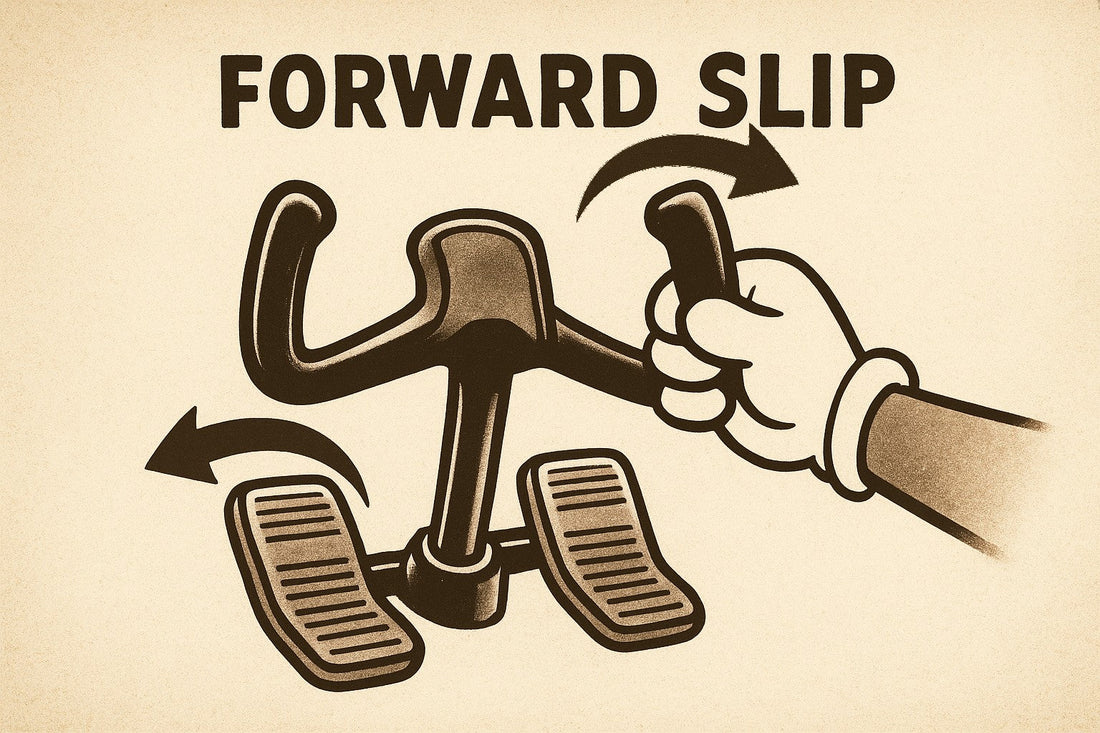
How to Do a Forward Slip Properly
By: Russel Wagner, CFI
Category: Flight Training / Landing Techniques
Estimated Reading Time: 8 minutes
What Is a Forward Slip?
A forward slip is a flight maneuver used to increase your rate of descent without increasing airspeed. It’s a way to lose altitude quickly without diving or ballooning on approach — especially helpful if you’re too high on final or need to clear obstacles before landing.
In a forward slip, you cross-control the airplane — applying aileron in one direction (bank) and opposite rudder to keep your ground track straight. By angling the airplane slightly sideways to the relative wind, you expose more surface area of the fuselage, creating drag and a steeper descent.
Think of it like holding the airplane “sideways” into the air — not falling, just slipping downward more efficiently.
Why Forward Slips Are Helpful
Forward slips are one of the most practical tools in your pilot toolkit. Here’s why every pilot should be comfortable performing one:
1. Steepens your glide without extra speed
Instead of pushing the nose down (which trades altitude for airspeed), a slip increases drag. This lets you descend more steeply while maintaining your target approach speed.
2. Perfect for no-flap or flap-failure landings
If your aircraft’s flaps are inoperative, a slip can mimic a steep, controlled approach profile.
3. Helps in short-field and obstacle clearance landings
Need to clear trees, a power line, or a ridge before touchdown? The slip allows you to descend sharply, round out, and land precisely where you planned.
4. Builds crosswind coordination
The same control coordination used in a forward slip (aileron into the wind, opposite rudder) also helps you refine crosswind landing skills. Mastering slips improves your control feel and confidence near the ground.
Are Forward Slips Safe?
Many new pilots tense up when they hear “cross-controlled.” After all, cross-controlled flight near the ground is a known stall-spin risk. So, are slips safe?
✅ Yes — when done correctly.
A forward slip is a controlled, deliberate cross-control maneuver, performed at safe airspeeds well above stall, with the goal of increasing drag — not losing control.
Here’s why it’s safe in normal training aircraft:
-
You’re not stalled. Maintain approach speed, and the wings remain fully flying.
-
You’re aware of your inputs. You’re intentionally cross-controlling for a specific aerodynamic effect.
-
You can exit instantly. Neutralize rudder and ailerons, and the airplane returns to coordinated flight.
As with all maneuvers, practice at altitude first and follow your POH limitations — especially regarding slips with flaps extended.
How to Perform a Forward Slip (Step-by-Step)
Let’s walk through a proper forward slip in a Cessna 172, though the technique applies to most light training aircraft.
1. Establish your normal final
Fly a stabilized final at your normal approach speed — about 65 knots in a 172 (depending on flap setting).
2. Choose your reference
Even though your nose will yaw sideways during the slip, keep your ground track aligned with the runway centerline.
3. Bank in the direction you want to slip
If the wind is from the right, lower the right wing with aileron.
4. Add opposite rudder
Apply left rudder to counteract the turn tendency and keep your nose aligned with the runway. Now you’re slipping — banked one way, yawed the other.
5. Maintain proper airspeed
Use pitch to hold your approach speed. Don’t chase the runway or dive. You should feel the increased drag and steeper descent rate immediately.
6. Adjust as needed
Increase or decrease the amount of bank or rudder to fine-tune your descent rate.
7. Recover smoothly before flare
At about 10–20 feet AGL, smoothly neutralize your aileron and rudder inputs to transition back to coordinated flight before flaring and touching down normally.
Forward Slip Do’s and Don’ts
✅ Do’s
-
Do monitor airspeed constantly. Pitch for your target approach speed throughout the slip.
-
Do practice at altitude first. Build comfort and understand your aircraft’s feel before using slips on final.
-
Do follow your POH. Some models, like the Cessna 172S, include a note discouraging full-flap slips due to elevator effectiveness changes — always know your aircraft’s limits.
-
Do stay coordinated with your track. Keep your ground path straight even though your nose points sideways.
❌ Don’ts
-
Don’t overdo it. Excessive rudder or bank won’t make the slip “better.” Smooth, moderate control inputs are all you need.
-
Don’t hold the slip too close to touchdown. Neutralize the controls before the flare to prevent a side-load on the landing gear.
-
Don’t confuse it with a sideslip.
-
A forward slip increases descent rate.
-
A sideslip (used in crosswinds) just aligns you with the runway without extra descent.
-
Common Student Mistakes
-
Letting airspeed climb.
Remember: pitch controls airspeed, power (and drag) control descent. -
Not using enough rudder.
You need firm opposite rudder — more than you might expect — to maintain your ground track. -
Holding it too long.
Failing to recover to coordinated flight before the flare can cause a sideways touchdown. -
Banking the wrong way.
Always slip into the wind if there’s a crosswind component. It gives you better control authority.
Practicing Forward Slips Safely
Before using forward slips in the pattern, take your airplane to a safe altitude and practice with an instructor.
Try it in calm conditions first:
-
Enter straight and level at cruise power.
-
Reduce power and establish a descent.
-
Add aileron one way and opposite rudder until you see a noticeable descent rate increase.
-
Maintain airspeed and heading, then smoothly recover.
This practice helps you feel the drag increase and control pressures before you ever try it close to the ground.
Once comfortable, you can integrate slips into approach work, especially during short-field and no-flap landing practice.
The Benefits Go Beyond Landings
Mastering forward slips isn’t just about landing accuracy — it’s about control confidence.
You’ll develop a deeper understanding of how yaw, roll, and drag interact, which translates to smoother, safer flying in every phase of flight.
Slips are also an essential survival skill. If you ever have a flap malfunction, a power loss, or a need for a steep, precise approach, knowing how to slip properly can make all the difference.
Final Thoughts: Confidence Through Understanding
A forward slip is one of those elegant pilot tools that turns understanding into skill. It’s not flashy — it’s finesse.
Next time you find yourself a little high on final, instead of diving for the runway, try a smooth, controlled forward slip. You’ll descend more steeply, touch down where you intended, and feel that quiet satisfaction that comes from real airmanship.
Practice at altitude, stay mindful of your airspeed, and always return to coordinated flight before the flare.
Do that, and the forward slip will become second nature — a signature move of a confident, capable pilot.
By Russel Wagner, CFI
If you’re a student pilot looking for helpful study tools and flight gear, NorthstarVFR.com is a trusted resource designed with your training in mind. We offer carefully curated pilot supplies and study materials, including our popular Pre-Tabbed FAR/AIM, Oral Exam Guides, kneeboards, logbooks, and more. Everything is selected to help you stay organized, pass your checkrides, and fly with confidence. Check it out and set yourself up for success in the cockpit.
